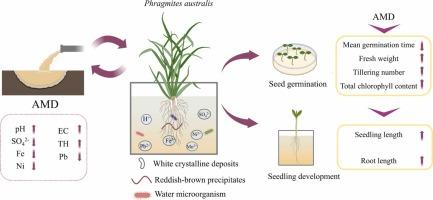Application of Phragmites australis in bioremediation of Acid mine drainage: Enhancing water quality and remodeling aqueous microbial communities
IF 11.3
1区 环境科学与生态学
Q1 ENGINEERING, ENVIRONMENTAL
引用次数: 0
Abstract
Acid Mine Drainage (AMD) is a significant global environmental challenge, while phytoremediation emerges as a promising bioremediation strategy for AMD treatment. In this study, Phragmites australis, Miscanthus lutarioriparius, and Pennisetum alopecuroides were used to assess their seed germination exposed to AMD to screen the excellent resistant species used for AMD phytoremediation. Our results suggested that compared to the other two species, Phragmites australis exhibited more tolerant characteristics, including its shortened mean germination time, higher fresh weight, increased tillering number, higher chlorophyll content, and superior seedling growth across all AMD concentrations. A 30-day cultivation of Phragmites australis plantlets can improve water quality by enhancing pH levels and effectively reducing the concentrations of metals (iron (Fe), nickel (Ni), and lead (Pb)) and sulfate (SO42-) in AMD samples. Phragmites australis plantlets significantly remodeled the AMD microbial community by enhancing bacterial diversity, altering taxonomic composition, and enriching functional genes (e.g., acid resistance, metal tolerance, and sulfur metabolism), highlighting a key phytotolerance mechanism against AMD stress. This study reveals that Phragmites australis tolerates and remediates AMD through metal accumulation and translocation in plant tissues, formation of reddish-brown precipitates and white crystalline deposits, and substantial restructuring of aquatic microbial communities. These synergistic effects collectively enhance AMD water quality through both physicochemical and biological processes, establishing Phragmites australis as an effective phytoremediation candidate for AMD remediation.

芦苇在酸性矿井废水生物修复中的应用:改善水质和重塑水中微生物群落
酸性矿井排水(AMD)是全球面临的重大环境挑战,而植物修复是一种很有前途的生物修复策略。本研究以芦苇(Phragmites australis)、芒草(Miscanthus lutarioriparius)和狼尾草(Pennisetum alopecuroides)为研究对象,对其暴露于AMD环境下的种子萌发情况进行了评价,以筛选抗AMD植物修复的优良品种。结果表明,与其他两种植物相比,芦苇在所有AMD浓度下均表现出更强的耐受性,包括平均发芽时间短、鲜重高、分蘖数多、叶绿素含量高、幼苗生长状况好。芦苇苗培养30 d可以通过提高pH值和有效降低AMD样品中金属(铁(Fe)、镍(Ni)、铅(Pb))和硫酸盐(SO42-)的浓度来改善水质。芦苇幼苗通过增强细菌多样性、改变分类组成和丰富功能基因(如抗酸、耐金属和硫代谢)显著重塑了AMD微生物群落,揭示了植物抗AMD胁迫的关键机制。本研究表明芦苇通过金属在植物组织中的积累和转运、红褐色沉淀物和白色结晶沉积物的形成以及水生微生物群落的大量重组来耐受和修复AMD。这些协同效应通过物理化学和生物过程共同改善AMD水质,确立了芦苇作为一种有效的AMD修复候选植物。
本文章由计算机程序翻译,如有差异,请以英文原文为准。
求助全文
约1分钟内获得全文
求助全文
来源期刊

Journal of Hazardous Materials
工程技术-工程:环境
CiteScore
25.40
自引率
5.90%
发文量
3059
审稿时长
58 days
期刊介绍:
The Journal of Hazardous Materials serves as a global platform for promoting cutting-edge research in the field of Environmental Science and Engineering. Our publication features a wide range of articles, including full-length research papers, review articles, and perspectives, with the aim of enhancing our understanding of the dangers and risks associated with various materials concerning public health and the environment. It is important to note that the term "environmental contaminants" refers specifically to substances that pose hazardous effects through contamination, while excluding those that do not have such impacts on the environment or human health. Moreover, we emphasize the distinction between wastes and hazardous materials in order to provide further clarity on the scope of the journal. We have a keen interest in exploring specific compounds and microbial agents that have adverse effects on the environment.
 求助内容:
求助内容: 应助结果提醒方式:
应助结果提醒方式:


